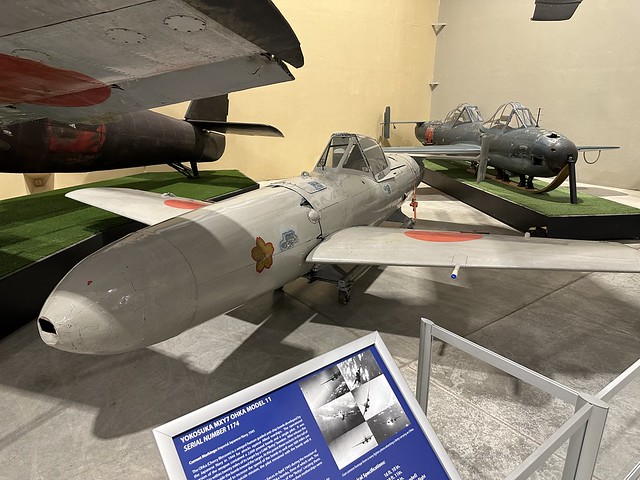An old friend’s in town. He served with me at Kadena Air Base in the early 1990s and was also a member of the Hash House Harriers running club my wife and I belonged to. We went out to dinner last night, then visited Pima Air & Space Museum this morning. There isn’t much new on display since my last update in October 2022, but I snapped a few photos anyway.
There are two new additions in the aero engine section just inside the museum’s front door, a Subaru 6-cylinder boxer used to power a small rotary-wing drone built by Boeing (left), and an experimental McCulloch 5-cylinder 2-stroke radial for light aircraft applications, never put into production (right).
 |
 |
NASA’s SOFIA aircraft, the Stratospheric Observatory for Infrared Astronomy, recently retired, is parked in an off-limits fenced area adjacent to the museum’s outdoor display area. I don’t know when it’ll be put on display, nor where they’re going to find room to park it, but it’s an impressive thing to see even behind the chain link fence.
I’m happy to report visible progress on PASM’s B-52A, Balls Three, a one-time mothership to the X-15 rocket planes. The tail section is sporting fresh paint, and there’s new high-vis striping on the wingtips and rear fuselage. After almost nine years in restoration, Balls Three must be getting very close to being put back on display.
The pedestrian bridge to the south display area is now open. Before, there was just one access point, it’s location unmarked. Consequently, few visitors ever found their way to the back lot. The new pedestrian bridge is in a well traveled area, and while my friend and I were there we saw visitors using it. That’s the former Orbis Flying Eye Hospital DC-10 behind me, by the way.
On loan from the Royal Air Force Museum, PASM now has the operational version of the Japanese Ohka “Cherry Blossom” rocket-powered manned bomb on display, sitting next to the two-seat trainer that’s been on display for a few years. The trainer used water ballast in the nose to duplicate the weight of the high explosives in the real thing, a second seat for the instructor, and a landing skid. The operational version dispensed with the second seat and the landing skid, it being intended for one-time use only. Four Ohkas and one or two trainers were seized by U.S. forces upon Japan’s surrender and shipped back to the States for study.
Neither my friend nor I were up for hiking the entire 80 acres of museum grounds, so it’s likely I missed one or two new outdoor exhibits. I promise to track them down on my next visit.
As for the museum itself, five or six tram tours of outdoor aircraft were available to visitors today. They’re now conducted by paid employees who narrate from a script while driving. There’s also a daily schedule of volunteer docent presentations at selected indoor display aircraft: a short talk about the Wright Brothers in front of the Wright Flyer replica at 10:00 AM, one on the SR-71 in front of the Blackbird at 11:00, three or four more at other indoor exhibits. That’s a definite improvement on what was available to visitors during my October visit.
Still, very little compared to what the museum offered visitors in its heyday. Other than the paid tram drivers outside, whom you only see behind the wheel of the trams they drive (and only hear if you’ve paid for a ride), and the docent who does the free presentations on selected indoor aircraft at scheduled times, there are no volunteers or guides in sight, and visitors are on their own in exploring the museum.
Well, my friend at least had a chatty guide to show him around.
As always, I set up a Flickr album for today’s photos. Click here to see it.



